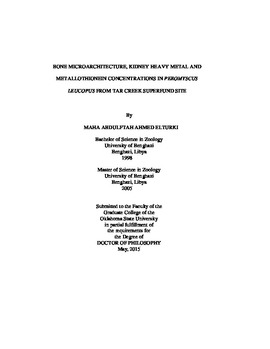| dc.contributor.advisor | Stoecker, Barbara J. | |
| dc.contributor.author | Elturki, Maha Abdulftah Ahmed | |
| dc.date.accessioned | 2016-01-20T15:45:38Z | |
| dc.date.available | 2016-01-20T15:45:38Z | |
| dc.date.issued | 2015-05 | |
| dc.identifier.uri | https://hdl.handle.net/11244/25746 | |
| dc.description.abstract | Tar Creek Superfund Site (TCSFS) is highly contaminated by toxic heavy metals. Cd, Pb, and Zn concentrations in soil and kidney specimens of P. leucopus were analyzed using inductively coupled plasma-mass spectroscopy (ICP-MS). The fourth lumbar vertebra (L4) of P. leucopus was used to assess heavy metal effects on bone density and fragility using micro-computed tomography (uCT). Metallothionein (MT) was measured by using an Enzyme Linked Immune Sorbent Assay (ELISA). The results showed significantly higher concentrations of Pb, Cd, and Zn in TCSFS soil than in the reference sites (Oologah Wildlife Management Area [OWMA] and Sequoyah National Wildlife Refuge [SNWR]). The soil Pb concentrations at the three sites were 1132+/-278, 6.4+/-1.1, and 2.3+/-0.3 mg/kg, respectively. Concentrations of Cd were 48+/-4, 0.15+/-0.03, and 0.06+/-0.01 mg/kg. A similar pattern was seen for Pb and Cd concentrations in kidney specimens with TCSFS being higher than the reference sites. The kidney Pb concentrations were 0.57+/-0.10, 0.04+/-0.01, 0.05+/-0.01 mg/g, and Cd concentrations were 4.62+/-0.71, 0.53+/-0.08, and 0.53+/-0.06 mg/g for TCSFS and two reference sites. In addition, micro CT analysis of L4 from TCSFS showed significant Pearson's correlation coefficients between Cd concentrations and trabecular bone number (-0.67, p<0.05) and trabecular separation (0.72, p<0.05).The results showed no correlation between bone parameters and mineral concentrations at reference sites. MT-1 concentrations in P. leucopus did not show statistically significant differences between TCSFS and reference sites (P>0.09). In conclusion, this study showed significant heavy metal contamination in kidney of small mammals from TCSFS and confirmed previous studies. However, the study added new physiological endpoints for assessment of the effects of environmental contaminants on small wild mammals used as indicators for human health. | |
| dc.format | application/pdf | |
| dc.language | en_US | |
| dc.rights | Copyright is held by the author who has granted the Oklahoma State University Library the non-exclusive right to share this material in its institutional repository. Contact Digital Library Services at lib-dls@okstate.edu or 405-744-9161 for the permission policy on the use, reproduction or distribution of this material. | |
| dc.title | Bone microarchitecture, kidney heavy metal and metallothionein concentrations in Peromyscus leucopus from Tar Creek Superfund Site | |
| dc.contributor.committeeMember | McBee, Karen | |
| dc.contributor.committeeMember | Zhang, Guolong | |
| dc.contributor.committeeMember | Gasem, Khaled A. M. | |
| osu.filename | ELTURKI_okstate_0664D_14008.pdf | |
| osu.accesstype | Open Access | |
| dc.type.genre | Dissertation | |
| dc.type.material | Text | |
| thesis.degree.discipline | Environmental Science | |
| thesis.degree.grantor | Oklahoma State University | |
